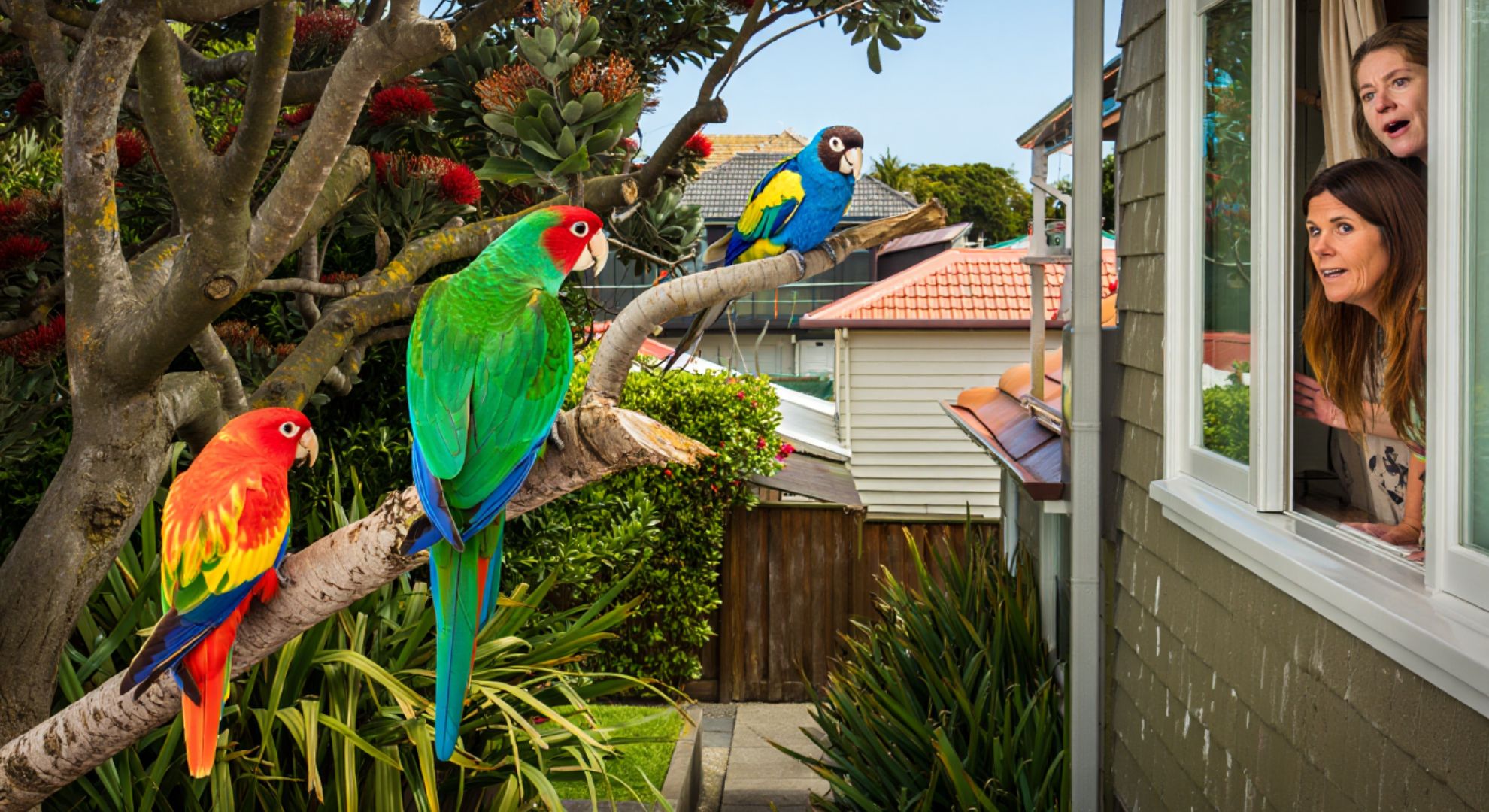The morning air felt unusually bright, as if the hills had spilled a little extra color into the city. Leaves shivered; lawns glittered; and then a burst of green and scarlet stitched the sky into ribbons. In a heartbeat, people paused with mugs halfway to their lips, listening to a sharp, silver chorus.
A flash of color, and a question
Feathers like fizzing paint, tails like green comets, a flicker of red at the crown. The birds cartwheeled between cabbage trees and pōhutukawa, landing long enough to rattle seed pods with beaks too clever by half.
“I did a double take,” said a nearby gardener, eyes wide. “They sounded like tiny party whistles, and then there they were—five of them, bold as day.”
Which parrots could they be?
Local birders raised a gentle eyebrow: Wellington already hosts native parrots in select pockets, alongside a few introduced cousins. Colors can mislead, and calls travel differently in wind and stone canyons.
Here’s a quick comparison people used while trading hurried sightings, photos, and audio clips:
| Species | Native to NZ? | Typical Color | Common Call | Seen in Wellington? | Status/Notes |
|---|---|---|---|---|---|
| Kākā | Yes | Brown/olive with red | Harsh “kā-ā” | Yes (kelp of bush) | Recovering in predator-controlled areas |
| Kākāriki (parakeet) | Yes | Bright green, red crown | Rapid chatter, “tseet” | Occasionally | Sensitive; prefers bushy habitats |
| Eastern rosella | No | Red head, yellow/green | Sweet, buzzy chatter | Common in suburbs | Established introduced species |
| Ring-necked parakeet | No | Lime with dark ring | Loud, ringing squawk | Occasional escapes | Small urban feral pockets possible |
Observers described vivid green bodies and a quick, chirring call—details that point toward bustling rosellas or a small group of kākāriki, depending on bill heft, flight style, and that telltale red on the forehead.
Why they’re visiting gardens now
Urban edges create warm, food-rich corridors: fruiting shrubs, bird feeders, compost heaps, and tidy lawns where insects are easy pickings. Predator control has stitched together safer routes, and spring swings open the gates for dispersing youth.
Climate variability also matters. Mild nights keep nectar flowing, and wind funnels birds into sheltered gullies where sound blooms and kitchens smell like toast.
The soundtrack matters
Parrots advertise themselves with confidence. Listen for fast, metallic chitters, a rising buzz before takeoff, or the classic parrot squawk that bounces off fences. Watch how they hang like little acrobats, using their beaks as a third limb to clamber and pry.
“They were methodical,” reported a jogger who paused under a puriri. “One bird kept watch while the others fed, like a tiny heist crew with feathers.”
Experts weigh in
City ornithologists urged delighted curiosity, tempered with care. “It’s a sign of urban habitats doing something right,” one researcher noted. “But we should avoid feeding sugary treats that change behavior or spread disease.”
A wildlife ranger added a nudge. “Good photos help with ID. If you can, catch the face, the wing bars, and the tail tip in the same frame.”
Why it feels astonishing
Parrots in a street of villas feels like the city is briefly tropical—a playful glitch in the expected palette. They carry the charisma of intelligence, the trickster charm of birds that watch you back. For a few minutes, time slows, and the ordinary garden becomes an edge of forest.
What residents can do
- Keep a respectful distance, observe quietly, and avoid sudden movements; report notable sightings to local bird groups with time, location, and clear photos.
Clues from the garden
Look for chewed seed heads under flax, neat bites from soft fruit, and a drift of faint feather down along fence lines. Fresh scratch marks on branches reveal busy feet and methodical foraging routes.
You might also notice patterns: groups arrive at first light, trace the same loop of trees, then vanish on a decisive wingbeat toward a nearby valley.
A small wonder with a bigger story
Moments like these remind a city that it sits inside a living catchment, with corridors of green that let creatures move and surprise us. Today it is a cloud of quick green, tomorrow perhaps a kākā’s rough call sawing the dusk into pieces.
In a neighborhood of hedges and letterboxes, a tiny band of airborne comedians wrote its own bright footnote across the morning. People smiled at strangers; children pointed; and the day, newly feathered, felt grander than it had any right to be.
